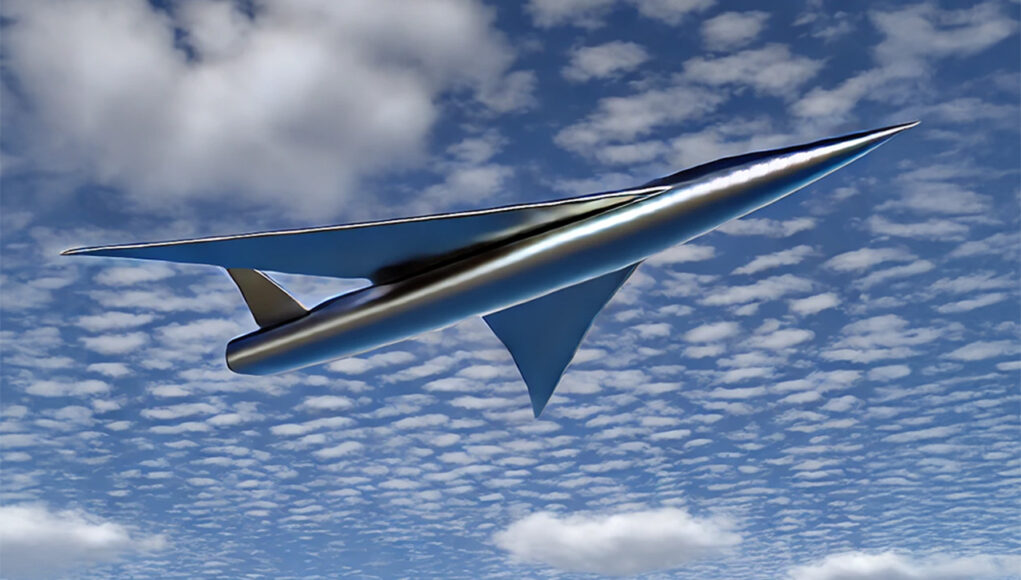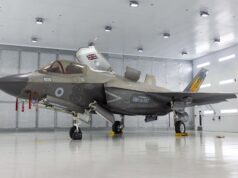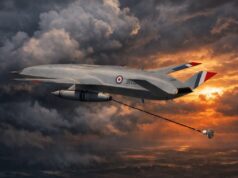The Ministry of Defence has revealed plans for a new long-range strike weapon under the codename Project Brakestop, which aims to produce a minimum of 20 units per month.
According to a Prior Information Notice published on 25 September 2024, this one-way attack system will be capable of targeting enemy assets from over 500km away and operating in high-threat tactical environments.
The system, referred to in the notice as a One-Way Effector (OWE) Heavy, is designed to strike targets accurately while navigating through a GNSS-denied environment and withstanding electromagnetic warfare.
The Ministry of Defence has not confirmed whether this will be a missile, drone, or another form of delivery system, but the emphasis is placed on flexibility and adaptability.
“The User requires a cost-effective, long-range (500km) One Way Effector Heavy, capable of being safely ground launched from a mobile platform in a high-threat tactical environment,” states the notice.
According to the MoD’s outline, the system is expected to:
– Deliver a 200-300kg payload (similar to the Mk 82 bomb) over a 600km range.
– Achieve speeds of around 600km/h.
– Be launched safely from a mobile platform in a high-threat environment, with reduced detection probability.
– Operate via either a ballistic trajectory or low-level cruise mode.
– Navigate in a GNSS-denied environment with targeted end-stage guidance.
The MoD places a strong emphasis on the system’s ability to survive in complex environments. The OWE Heavy must operate under conditions that involve electromagnetic environments, all while remaining resistant to EW attacks and spoofing. This ensures its effectiveness in modern warfare scenarios where such measures are increasingly prevalent.
The Ministry of Defence has laid out requirements for the system to be scalable in its production, capable of delivering at least 20 units per month, with the potential for further expansion if needed. “Manufacturing shall be scalable to meet requirements at a minimum of 20 units-per-month, with the ability to further increase,” the MoD specifies.
This scalability focuses on delivering results quickly, with the MoD prioritising efficient production over intricate design details, in order to meet the growing need for rapid deployment.
While the exact nature of the delivery system is not confirmed, the project allows for flexibility. Whether a missile, drone, or another technology, the system must operate efficiently under a range of conditions. “This can be done via (ballistic or low-level cruise) and could use a missile a drone or another technology to deliver effect,” the notice explains.
This flexibility extends to the system’s ability to launch from mobile platforms, providing an adaptable response to the modern battlefield’s changing needs.
As part of the development process, the Ministry of Defence will hold an industry day on 9 October 2024 in London. This event is designed to allow industry participants to showcase their potential solutions to different aspects of the project, including propulsion systems, navigation, targeting, and launcher systems.
Project Brakestop is operating on an ambitious timeline, aiming for a demonstration firing by Q3 2025 and potential serial production from Q4 2025. “There is an aggressive timeline of a demonstration firing in Q2 2025 and, subject to contract, potential serial production from Q3 2025, producing a minimum around 20 platforms per month.”














Not to build 20 a month, not even designed them yet or ordered them. 1 more item on the magic roundabout fairy tale wish list that we never happen.
Didn’t the Germans Build something like this during WW11 named it V something where the Engine stopped and then it glided to the city of London
Doodlebug.
The engine only stopped before it dropped down indiscriminately. It flew to London in its own power.
One of them just missed my Nanny.
Didn’t have a Nanny in the Summer of 1944 but acted as the “V1 Street Lookout” during the School Holidays. Majority of V1s landed in and around the then Surrey , Borough of Croydon, not the City of London. Our house was damaged by a near miss but “only lightly”. Now, should we/could we rearm our vintage Spitfires as an anti Cruise Missile force? Perhaps only the Griffon engined ones? Don’t seem to have much else’ in the ready locker’.
Yes. My Grandmother, who all us grandkids called “Nanny” was in New Malden. My Grandad was away as a steel engineer at Farnborough, Portsmouth, and other places I know not. I’m gutted I never asked him.
Nanny always talked to us of the V1s.
I had a nan, as well not a granny, my wife had a granny because according to her family nannies are paid for…funny the differences within British culture.
Morning J.
Yes, I’ve pondered that before myself.
I was sad to learn after my Nanny died that she’d always wanted to be called Grandma. But all us grandkids called her Nanny so that stuck.
I had a Nanna, although she was evacuated so didn’t have any stories about V1s or V2s. My Pappa did though, he lived around Esher, said he still very vividly remembered the sound they made…
Strangely enough, I recall my Nanny was also evacuated. 🤔
I guess she somehow went back.
Well, that was more towards 1944-45 when the V-weapons were being used as I recall, a good 2 years after the worst of the blitz. I can believe that some kids went home after 1942/43 maybe?
A V2 hit Gravesend in Kent towards the end of the war. This particular missile was believed to have been sabotaged and was a dud. For years it’s engine was on display at the entrance to the Canal Gardens and you could climb up onto it and have your picture taken
The Luftwaffe also dropped “air mines” over dockyards like Chatham, these came down on parachutes with a 500kg payload. One dropped on Rochester during the Blitz and blew up about 150yards high, turning the Rochester Delce residential area into a huge crater.
My nan was in an Anderson shelter dug in at the bottom of the garden and survived, but her house was flattened
The Air mines were literally naval mines dropped on land targets.
Morning mate.
No stopping the V2 at that time. The V1s at least could be caught and tipped off course.
Scuse my ignorance but, apart from calling it a drone, how does this differ from a sub-sonic cruise missile, in this context? To me, drones are low cost, typically deployable by a single operator and typically with a video guidance system.
I’ve seen the argument that cruise missiles are really a type of drone in terms of how they function.
The ask from the MoD is quite vague in that respect. They’ve left the door open to not only cruise missiles and drones, but also ballistic weapons. This request is part of the Army’s overall long range fires requirement.
I guess this request has come about from observations on how well Ukrainian long range drones are doing. Yes, the Russian air defences are shooting the majority of them down. But at least 1/3 are getting through. The other obvious result is that Russia must expend surface to air missiles or use manned aircraft launching air to air weapons to take out the drones. As it’s a threat that can’t be ignored. Carrying up to 250kg of HE, will have a significant effect on the selected target. Which has been clearly shown in a number of highly publicized attacks on key Russian infrastructure, such as ammo dumps and fuel refineries.
The drones are very basic in their construction methods. Any RC plane builder will recognize and be comfortable building these types of drones. Which are basically foam cores sandwiched by fiberglass. Which means you don’t really need skilled Labour or expensive CNC tooling to build the drone. It also means that a cottage industry can quite easily be set up to churn out loads of them.
When it comes to a cruise missile. The demarcation between it and a drone is getting quite blurred. Traditionally a cruise missile is turbojet or ramjet powered and cruises at 500mph to Mach 4. However, to get more range, they have been reducing the thrust of the turbojet. So it can cruise at around 350 to 400mph. Then accelerating again when it gets near the target.
Similarly drones traditionally operated at around 100 to 150mph. But now Iran has given Russia the jet powered Shahed. Which can cruise at 300+mph. Which is similar to the IC and jet powered Banshees we’ve given Ukraine. That depending on the payload can cruise between 250 and 400mph.
The Qinetiq Banshee would be an obvious candidate for the Army’s requirement. You can vary the payload depending on the effects needed on the target or the range required. The airframe can easily be scaled up. Which with a more powerful engine, would allow for either more cruising speed or range to carry a heavier payload. Where you would still be looking at about a 400mph performance. Though it would need a better launch method, that should also incorporate folding wings. So that it can be packaged in a smaller self-contained launcher. That makes it quicker and easier to launch from the back of a truck.
There are now a large number of methods that you could use for guidance, when GPS cannot be guaranteed. Such as Mobile phone data link with first person view (FPV) and waypoint updates, similarly a satellite phone data link can do the same as this operates on a different frequency to GPS, astral navigation is another that can’t be jammed, to traditional inertial navigation that uses terrain recognition to maintain the track. With quantum navigation on the near horizon as well.
The issue is cost and the desired accuracy. However it has been shown that when using a mobile phone network along with FPV, it can deliver a very accurate weapon system for not a lot of cost.
Should we not be sending these to Ukraine early next year so they can test them out in real scenarios and make sure they work, then any adjustments can be made before we start full production?
If they are going to produce 20 a month I would imagine that is where a fair few will end up.
I would imagine this Is exactly where they will be sent as we are in the national collaborative drone development program to supply to ukraine and develop the tech . And supplying to ukraine means we will be constantly at the pointy end of drone development . We’ll thats the theory Its good that uk even recognises drone development is essential
But don’t tell poooootin
The ‘either or’ capability wish list will add complexity and unit cost. Surely better to buy 10 ballistic style per month and 10 cruise style per month. Each optimised for it’s role. Rocket v jet ?
I would imagine it’s not that they are looking for both ballistic and cruise, it’s more they are not settled on either…so whatever comes out best. If they wanted both they would have said with a ballistic and cruise profile.
That’s my take. They specify a required effect. It’s up to industry to put forward proposals to meet that requirement. It can’t hurt that there are effectively open warfare lab experiments ongoing around the world at present, especially in Ukraine and the Persian Gulf, constantly under intense scrutiny, with lessons learned every week, I would think..
An updated version of the V1 would be cheap and easy to manufacture for Ukraine.
Build them and bank them., they’ll be use of use sometime in the next 20 years definately.
And Build them cheap. The Russians and Iranians can throw huge numbers of theirs down range as they are cheap.
George,I trust you remembered to secure copywright of that missile image from Dan Dare!
What about the launch platform for this? Will it be a MAN truck 6-8×8 or Boxer or something else?
With a 600+ km range it’d be a waste to put it on an armoured platform like boxer. Steel frame based on a pallet size, like that AA gun that they were showing a month or two ago, so it can go on any flatbed in inventory and be dropped off easily.
Importantly if the UK can get this order into service and build up a stockpile of these heavy drones that would be very very sensible. We need hundreds of these things in reserve as the war in Ukraine has demonstrated without any doubt just how many can be used in high intensity warfare.
I think it’s also important to keep the design simple. Where it doesn’t need expensive tooling to build. For me the easiest and less expensive option, would be to base a family of drones on the existing Banshee. Which can be either jet powered or IC engined. Plus scaled up in size for increased range and/or vary sizes of payload.
Being predominantly constructed using fiberglass. This gives it quite a low radar signature which will aid it at penetrating an enemy’s air defences. But more importantly it means you don’t need skilled labour to manufacture and assemble it. You could very easily set up a highly dispersed cottage industry to churn out the airframes. Then have them completed with engine, warhead etc elsewhere.
Secondly to keep costs down, I would base the guidance system on a cheap GPS. But backed up with an inertial navigation system that uses the mobile phone network to provide course correction updates. It’s proven very hard to disable a Country’s need to keep their mobile phone network running. You could also include FPV for terminal guidance and target recognition.
But using the Banshee as the base design for suicide drones. You would have a cheap but highly effective family of drones, tailored for effects or range. That can be mass produced on a very limited budget.
Afternoon Davey, like it. If Banshee based that could then potentially take off from the carriers if project Ark Royal gets actioned.
What about cardboard plastic and plywood
Yes. The materials are a known quantity, so why not. If the speed of the drone is kept below transonic, heat issues won’t be a problem.
With the aim to deliver the equivalent of a mark 82 warhead 200/300kg, this will have to be much larger than Banshee. The suggested speed also seems to rule out a ballistic weapon.
Got loads of stuff in Cumbria to make dirty bombs